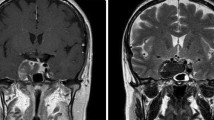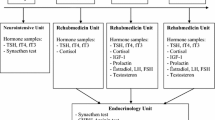Abstract
Background: Subarachnoid hemorrhage (SAH) is a potential cause of hypopituitarism. Most of the studies regarding the relationship between SAH and anterior pituitary function were retrospective and hormonal assessment was performed several months after SAH. Aim: To prospectively evaluate the prevalence of anterior pituitary hormone deficiencies in the acute phase after spontaneous SAH and their possible correlation with clinical and radiological parameters. Methods: Pituitary function was tested in 60 patients within 72 h after spontaneous SAH. Results: 56.9% of the patients showed at least one anterior pituitary hormone deficiency: gonadotropin and GH secretion failure represented the most prevalent hormonal deficiencies (33.3 and 22.0%, respectively), whereas ACTH and TSH deficiency was less frequent (7.1 and 1.8%, respectively). With the exception of secondary hypogonadism, the prevalence of other pituitary hormone deficiencies is in agreement with previous studies, which evaluated pituitary function on long-term follow up after SAH. No correlation was found between hypopituitarism and clinical status, as assessed with Hunt-Hess and Glascow Coma Scales. Moreover, no correlation was found between hypopituitarism and bleeding severity evaluated with Fisher’s scale. Conclusions: We demonstrated a high prevalence of anterior pituitary hormone deficiencies acutely after SAH. Although part of GH and gonadotropin deficiencies might be a consequence of functional alteration due to SAH itself, the finding of low cortisol levels in this stressful condition strongly suggests the presence of true hypocortisolism. Therefore, an evaluation of pituitary function shortly after SAH might be useful to identify a subset of patients who deserve a more accurate follow-up.
Similar content being viewed by others
References
van Gijn J, Rinkel GJ. Subarachnoid haemorrhage: diagnosis, causes and management. Brain 2001, 124: 249–78.
Schneider HJ, Kreitschmann-Andermahr I, Ghigo E, Stalla GK, Agha A. Hypothalamopituitary dysfunction following traumatic brain injury and aneurysmal subarachnoid hemorrhage. JAMA 2007, 12: 1429–38.
Kelly DF, Gonzalo IT, Cohan P, Berman N, Swerdloff R, Wang C. Hypopituitarism following traumatic brain injury and aneurismal subarachnoid hemorrhage; a preliminary report. J Neurosurg 2000, 93: 743–52.
Kreitschmann-Andermahr I, Hoff C, Niggemeier S, et al. Pituitary deficiency following aneurysmal subarachnoid haemorrhage. J Neurol Neurosurg Psychiatry 2003, 74: 1133–5.
Kreitschmann-Andermahr I, Hoff C, Saller B, et al. Prevalence of pituitary deficiency in patients after aneurysmal subarachnoid hemorrhage. J Clin Endocrinol Metab 2004, 89: 4986–92.
Brandt L, Säveland H, Valdemarsson S, Sjöholm H, Reinstrup P. Fatigue after aneurismal subarachnoid hemorrhage evaluated pituitary function and 3D-CBF. Acta Neurol Scand 2004, 109: 91–6.
Aimaretti G, Ambrosio MR, Di Somma C, et al. Traumatic brain injury and subarachnoid haemorrhage are conditions at high risk for hypopitutarism: screening study at 3 months after the brain injury. Clin Endocrinol (Oxf) 2004, 61: 320–6.
Aimaretti G, Ambrosio MR, Di Somma C, et al. Residual pituitary function after brain injury-induced hypopitutarism: a prospective 12-months study. J Clin Endocrinol Metab 2005, 90: 6085–92.
Dimopoulou I, Kouyialis AT, Tzanella M, et al. High incidence of neuroendocrine dysfunction in long-term survivors of aneurismal subarachnoid hemorrhage. Stroke 2004, 35: 2884–9.
Tanriverdi F, Dagli AT, Karaca Z, et al. High risk of pituitary dysfunction due to aneurysmal subarachnoid haemorrhage: a prospective investigation of anterior pituitary function in the acute phase and 12 months after the event. Clin Endocrinol (Oxf) 2007, 67: 931–7.
Mangieri P, Suzuki K, Ferreira M, Domingues L, Casulari LA. Evaluation of pituitary and thyroid hormones in patients with sub-arachnoid hemorrage due to ruptured intracranial aneurysm. Arq Neuropsiquiatr 2003, 61: 14–9.
Jennet B, Bond M. Assessment of outcome after severe brain-damage. Lancet 1975, 1: 480–4.
Hunt WE, Hess RM. Surgical risk as related to time of intervention in the repair of intracranial aneurysms. J Neurosurg 1968, 28: 14–20.
Fisher CM, Kistler JP, Davis JM. Relation of cerebral vasospasm to subarachnoid hemorrhage visualized by computerized tomographic scanning. Neurosurgery 1980, 6: 1–9.
Leal-Cerro A, Flores JM, Rincon M, et al. Prevalence of hypopituitarism and growth hormone deficiency in adults long-term after severe traumatic brain injury. Clin Endocrinol (Oxf) 2005, 62: 525–32.
Lamberts SW, de Herder WW, van der Lely AL. Pituitary insufficiency. Lancet 1998, 352: 127–34.
Hartman ML, Crowe BJ, Biller BM, Ho KK, Clemmons DR, Chipman JJ. Which patients do not require a GH stimulation test for the diagnosis of adult GH deficiency? J Clin Endocrinol Metab 2002, 87: 477–85.
Nieschlag E, Swerdloff R, Behre HM, et al. Investigation, treatment and monitoring of late-onset hypogonadism in males. ISA, ISSAM, and EAU recommendations. EurUrol 2005, 48: 1–4.
Young R, Worthley LI. Diagnosis and management of thyroid disease and the critically ill patient. Crit Care Resusc 2004, 6: 295–305.
Stratakis CA, Chrousos GP. Neuroendocrinology and pathophysiology of the stress system. Ann N Y Acad Sci 1995, 29: 1–18.
Mesotten D, Vanhorebeek I, Van den Berghe G. The altered adrenal axis and treatment with glucocorticoids during critical illness. Nat Clin Pract Endocrinol Metab 2008, 4: 496–505.
Fisher LA, Ko N, Miss J, et al. Hypernatremia predicts adverse cardiovascular and neurological outcomes after SAH. Neurocrit Care 2006, 5: 180–5.
Author information
Authors and Affiliations
Corresponding author
Rights and permissions
About this article
Cite this article
Parenti, G., Cecchi, P.C., Ragghianti, B. et al. Evaluation of the anterior pituitary function in the acute phase after spontaneous subarachnoid hemorrhage. J Endocrinol Invest 34, 361–365 (2011). https://doi.org/10.1007/BF03347460
Published:
Issue Date:
DOI: https://doi.org/10.1007/BF03347460




